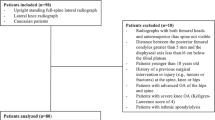Abstract
Introduction
Many studies regarding spinal sagittal alignment were focused mainly on above-hip structures, not considering the knee joint. Knee–spine syndrome was proposed earlier, but the mechanism of this phenomenon has not been revealed. The aim of the study was to demonstrate how spinopelvic alignment and sagittal balance change in response to simulated knee flexion in normal non-diseased population.
Methods
Thirty young male were enrolled in the study cohort. Two motion-controlled knee braces were used to simulate knee flexion of 0°, 15°, and 30° settings. Whole spine and lower extremity lateral radiographs were taken at each knee setting of 0°, 15°, and 30° flexion. Spinal and pelvic parameters were measured, including two angular parameters, femoropelvic angle (FPA) and femoral tilt angle (FTA).
Results
The following equation can be made; PT (pelvic tilt) = FPA + FTA. The mean values of FPA and lumbar lordosis decreased significantly at 15° and 30° knee settings compared to the parameters at the 0° knee setting, while the mean values of pelvic tilt and sacral slope rarely changed. Results also showed FTA was not correlated with PT, but strongly correlated with FPA (R = −0.83, p < 0.01).
Conclusions
The knee flexion resulted in decrease of lumbar lordosis without a significant change of pelvic posture in non-diseased population group.





Similar content being viewed by others
References
Bernhardt M, Bridwell KH (1989) Segmental analysis of the sagittal plane alignment of the normal thoracic and lumbar spines and thoracolumbar junction. Spine (Phila Pa 1976) 14:717–721
Berthonnaud E, Dimnet J, Roussouly P, Labelle H (2005) Analysis of the sagittal balance of the spine and pelvis using shape and orientation parameters. J Spinal Disord Tech 18:40–47
Cohen J (1988) Statistical power analysis for the behavioural sciences, 2nd edn. Lawrence Erlbaum Associates, Hillsdale
Gelb DE, Lenke LG, Bridwell KH, Blanke K, McEnery KW (1995) An analysis of sagittal spinal alignment in 100 asymptomatic middle and older aged volunteers. Spine (Phila Pa 1976) 20:1351–1358
Glassman SD, Bridwell K, Dimar JR, Horton W, Berven S, Schwab F (2005) The impact of positive sagittal balance in adult spinal deformity. Spine (Phila Pa 1976) 30:2024–2029
Jackson RP, Hales C (2000) Congruent spinopelvic alignment on standing lateral radiographs of adult volunteers. Spine (Phila Pa 1976) 25:2808–2815
Lafage V, Schwab F, Patel A, Hawkinson N, Farcy JP (2009) Pelvic tilt and truncal inclination: two key radiographic parameters in the setting of adults with spinal deformity. Spine (Phila Pa 1976) 34:E599–E606
Lazennec JY, Ramare S, Arafati N, Laudet CG, Gorin M, Roger B, Hansen S, Saillant G, Maurs L, Trabelsi R (2000) Sagittal alignment in lumbosacral fusion: relations between radiological parameters and pain. Eur Spine J 9:47–55
Mangione P, Senegas J (1997) Sagittal balance of the spine. Rev Chir Orthop Reparatrice Appar Mot 83:22–32
Min K, Hahn F, Leonardi M (2007) Lumbar spinal osteotomy for kyphosis in ankylosing spondylitis: the significance of the whole body kyphosis angle. J Spinal Disord Tech 20:149–153
Murata Y, Takahashi K, Yamagata M, Hanaoka E, Moriya H (2003) The knee–spine syndrome. Association between lumbar lordosis and extension of the knee. J Bone Joint Surg Br 85:95–99
Roussouly P, Nnadi C (2010) Sagittal plane deformity: an overview of interpretation and management. Eur Spine J 19:1824–1836
Roussouly P, Pinheiro-Franco JL (2011) Biomechanical analysis of the spino-pelvic organization and adaptation in pathology. Eur Spine J 20(Suppl 5):609–618
Schwab F, Lafage V, Boyce R, Skalli W, Farcy JP (2006) Gravity line analysis in adult volunteers: age-related correlation with spinal parameters, pelvic parameters, and foot position. Spine (Phila Pa 1976) 31:E959–E967
Schwab F, Lafage V, Patel A, Farcy JP (2009) Sagittal plane considerations and the pelvis in the adult patient. Spine (Phila Pa 1976) 34:1828–1833
Schwab F, Patel A, Ungar B, Farcy JP, Lafage V (2010) Adult spinal deformity-postoperative standing imbalance: how much can you tolerate? An overview of key parameters in assessing alignment and planning corrective surgery. Spine (Phila Pa 1976) 35:2224–2231
Vaz G, Roussouly P, Berthonnaud E, Dimnet J (2002) Sagittal morphology and equilibrium of pelvis and spine. Eur Spine J 11:80–87
Yoshimoto H, Sato S, Masuda T, Kanno T, Shundo M, Hyakumachi T, Yanagibashi Y (2005) Spinopelvic alignment in patients with osteoarthrosis of the hip: a radiographic comparison to patients with low back pain. Spine (Phila Pa 1976) 30:1650–1657
Acknowledgments
The current study was supported by Central Research Fund (nonprofit academic fund) from our institute. This study was conducted under approval of IRB.
Conflict of interest
None.
Author information
Authors and Affiliations
Corresponding author
Rights and permissions
About this article
Cite this article
Lee, C.S., Park, S.J., Chung, S.S. et al. The effect of simulated knee flexion on sagittal spinal alignment: novel interpretation of spinopelvic alignment. Eur Spine J 22, 1059–1065 (2013). https://doi.org/10.1007/s00586-013-2661-4
Received:
Revised:
Accepted:
Published:
Issue Date:
DOI: https://doi.org/10.1007/s00586-013-2661-4




